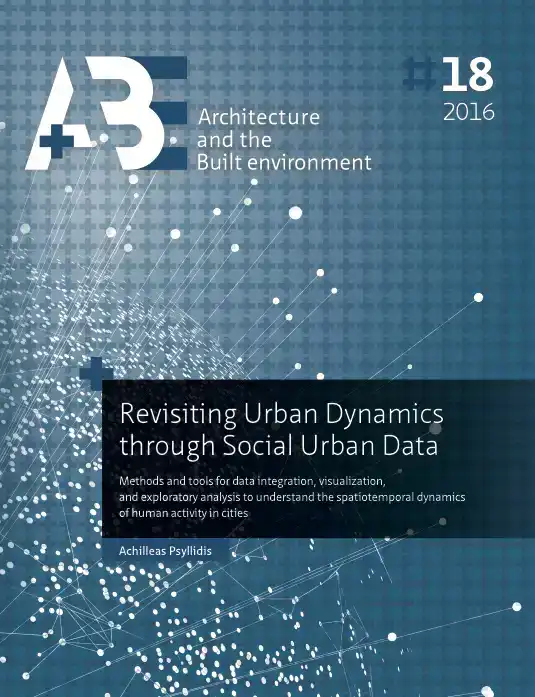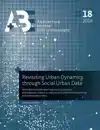- Engels
- Study
- nature & science
- technische wetensch.
- bouwkunde
- REVISITING URBAN DYNAMICS THROUGH SOCIAL URBAN DATA
PSYLLIDIS, ACHILLEAS
REVISITING URBAN DYNAMICS THROUGH SOCIAL URBAN DATA
29,95incl BTW
Vertrouwd sinds 1927
Persoonlijke aandacht en advies
Vanaf 17,50 gratis verzenden NL & BE
Meer dan 150.000 artikelen online
Omschrijving REVISITING URBAN DYNAMICS THROUGH SOCIAL URBAN DATA
The study of dynamic spatial and social phenomena in cities has evolved rapidly in the recent years, yielding new insights into urban dynamics. This evolution is strongly related to the emergence of new sources of data for cities (e.g. sensors, mobil
e phones, online social media etc.), which have potential to capture dimensions of social and geographic systems that are difficult to detect in traditional urban data (e.g. census data). However, as the available sources increase in number, the prod
uced datasets increase in diversity. Besides heterogeneity, emerging social urban data are also characterized by multidimensionality. The latter means that the information they contain may simultaneously address spatial, social, temporal, and topical
attributes of people and places. Therefore, integration and geospatial (statistical) analysis of multidimensional data remain a challenge. The question which, then, arises is how to integrate heterogeneous and multidimensional social urban data into
the analysis of human activity dynamics in cities?
To address the above challenge, this thesis proposes the design of a framework of novel methods and tools for the integration, visualization, and exploratory analysis of large-scale and het
erogeneous social urban data to facilitate the understanding of urban dynamics. The research focuses particularly on the spatiotemporal dynamics of human activity in cities, as inferred from different sources of social urban data. The main objective
is to provide new means to enable the incorporation of heterogeneous social urban data into city analytics, and to explore the influence of emerging data sources on the understanding of cities and their dynamics.
In mitigating the various he
terogeneities, a methodology for the transformation of heterogeneous data for cities into multidimensional linked urban data is, therefore, designed. The methodology follows an ontology-based data integration approach and accommodates a variety of se
mantic (web) and linked data technologies. A use case of data interlinkage is used as a demonstrator of the proposed methodology. The use case employs nine real-world large-scale spatiotemporal data sets from three public transportation organizations
, covering the entire public transport network of the city of Athens, Greece.
To further encourage the consumption of linked urban data by planners and policy-makers, a set of webbased tools for the visual representation of ontologies and li
nked data is designed and developed. The tools - comprising the OSMoSys framework - provide graphical user interfaces for the visual representation, browsing, and interactive exploration of both ontologies and linked urban data.
After introd
ucing methods and tools for data integration, visual exploration of linked urban data, and derivation of various attributes of people and places from different social urban data, it is examined how they can all be combined into a single platform. To
achieve this, a novel web-based system (coined SocialGlass) for the visualization and exploratory analysis of human activity dynamics is designed. The system combines data from various geo-enabled social media (i.e. Twitter, Instagram, Sina Weibo) an
d LBSNs (i.e. Foursquare), sensor networks (i.e. GPS trackers, Wi-Fi cameras), and conventional socioeconomic urban records, but also has the potential to employ custom datasets from other sources.
A real-world case study is used as a demons
trator of the capacities of the proposed web-based system in the study of urban dynamics. The case study explores the potential impact of a city-scale event (i.e. the Amsterdam Light festival 2015) on the activity and movement patterns of different s
ocial categories (i.e. residents, non-residents, foreign tourists), as compared to their daily and hourly routines in the periods before and after the event. The aim of the case study is twofold. First, to assess the potential and limitations of the
proposed system and, second, to investigate how different sources of social urban data could influence the understanding of urban dynamics.
The contribution of this doctoral thesis is the design and development of a framework of novel metho
ds and tools that enables the fusion of heterogeneous multidimensional data for cities. The framework could foster planners, researchers, and policy makers to capitalize on the new possibilities given by emerging social urban data. Having a deep unde
rstanding of the spatiotemporal dynamics of cities and, especially of the activity and movement behavior of people, is expected to play a crucial role in addressing the challenges of rapid urbanization. Overall, the framework proposed by this researc
h has potential to open avenues of quantitative explorations of urban dynamics, contributing to the development of a new science of cities.
e phones, online social media etc.), which have potential to capture dimensions of social and geographic systems that are difficult to detect in traditional urban data (e.g. census data). However, as the available sources increase in number, the prod
uced datasets increase in diversity. Besides heterogeneity, emerging social urban data are also characterized by multidimensionality. The latter means that the information they contain may simultaneously address spatial, social, temporal, and topical
attributes of people and places. Therefore, integration and geospatial (statistical) analysis of multidimensional data remain a challenge. The question which, then, arises is how to integrate heterogeneous and multidimensional social urban data into
the analysis of human activity dynamics in cities?
To address the above challenge, this thesis proposes the design of a framework of novel methods and tools for the integration, visualization, and exploratory analysis of large-scale and het
erogeneous social urban data to facilitate the understanding of urban dynamics. The research focuses particularly on the spatiotemporal dynamics of human activity in cities, as inferred from different sources of social urban data. The main objective
is to provide new means to enable the incorporation of heterogeneous social urban data into city analytics, and to explore the influence of emerging data sources on the understanding of cities and their dynamics.
In mitigating the various he
terogeneities, a methodology for the transformation of heterogeneous data for cities into multidimensional linked urban data is, therefore, designed. The methodology follows an ontology-based data integration approach and accommodates a variety of se
mantic (web) and linked data technologies. A use case of data interlinkage is used as a demonstrator of the proposed methodology. The use case employs nine real-world large-scale spatiotemporal data sets from three public transportation organizations
, covering the entire public transport network of the city of Athens, Greece.
To further encourage the consumption of linked urban data by planners and policy-makers, a set of webbased tools for the visual representation of ontologies and li
nked data is designed and developed. The tools - comprising the OSMoSys framework - provide graphical user interfaces for the visual representation, browsing, and interactive exploration of both ontologies and linked urban data.
After introd
ucing methods and tools for data integration, visual exploration of linked urban data, and derivation of various attributes of people and places from different social urban data, it is examined how they can all be combined into a single platform. To
achieve this, a novel web-based system (coined SocialGlass) for the visualization and exploratory analysis of human activity dynamics is designed. The system combines data from various geo-enabled social media (i.e. Twitter, Instagram, Sina Weibo) an
d LBSNs (i.e. Foursquare), sensor networks (i.e. GPS trackers, Wi-Fi cameras), and conventional socioeconomic urban records, but also has the potential to employ custom datasets from other sources.
A real-world case study is used as a demons
trator of the capacities of the proposed web-based system in the study of urban dynamics. The case study explores the potential impact of a city-scale event (i.e. the Amsterdam Light festival 2015) on the activity and movement patterns of different s
ocial categories (i.e. residents, non-residents, foreign tourists), as compared to their daily and hourly routines in the periods before and after the event. The aim of the case study is twofold. First, to assess the potential and limitations of the
proposed system and, second, to investigate how different sources of social urban data could influence the understanding of urban dynamics.
The contribution of this doctoral thesis is the design and development of a framework of novel metho
ds and tools that enables the fusion of heterogeneous multidimensional data for cities. The framework could foster planners, researchers, and policy makers to capitalize on the new possibilities given by emerging social urban data. Having a deep unde
rstanding of the spatiotemporal dynamics of cities and, especially of the activity and movement behavior of people, is expected to play a crucial role in addressing the challenges of rapid urbanization. Overall, the framework proposed by this researc
h has potential to open avenues of quantitative explorations of urban dynamics, contributing to the development of a new science of cities.
Specificaties
- MerkBK Books
- GroepTECHNISCHE WETENSCH (950)
- Barcode9789492516206
- LeverstatusActief
Reviews
0.0/5.0
Gemiddelde uit 0 reviews
Meest behulpzame reviews
Nog geen reviews geschreven


